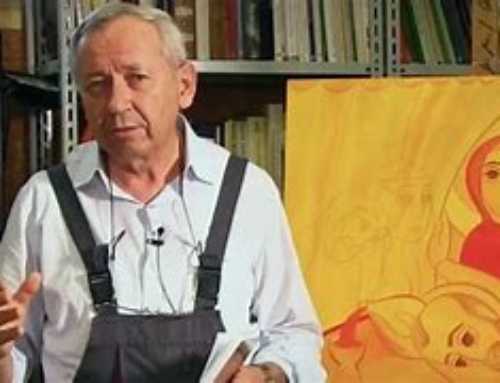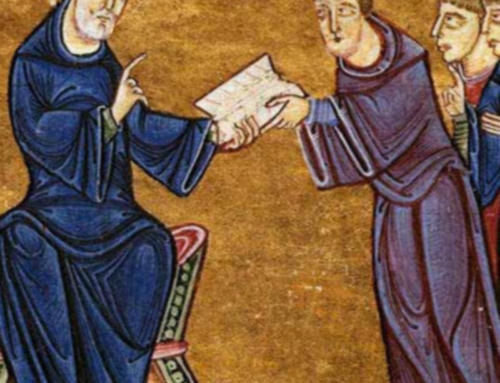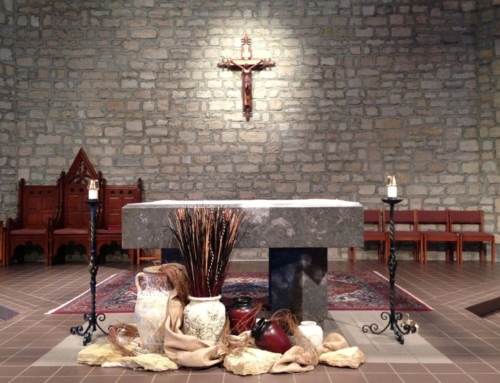I’ve always been saddened that traditionalist Catholics are so often burdened by the extremists who give their movement an angry face. You know the sort I mean…the ones who seem to be on a constant self righteous rant about the apostasy, corruption and immorality in the church, the conspiracy theorists, racists, flat earth guys and sedevacantists–not to mention the uptight, Puritanical folks with pursed lips and angry eyes.
They’re not the best of the traditionalists, but God bless ’em. Such members of the Body of Christ we shall always have with us, but they give an unfortunate face to traditionalist Catholicism just as much as the loopy left wingers, New Agers, feminists and pro-LGBTQ radicals give the more liberal Catholics a bad name.
I’m on the side of the traditionalists for the most part, and certainly have more in common with them than I have disagreements. Therefore it was a joy to spend a week at Clear Creek Monastery in Oklahoma. It was a joy because I spent my week with a gang of guys who show us the positive and powerful face of traditionalist Catholicism.
For those who don’t know, Clear Creek Abbey has a wonderfully unique story. You can read about it here. The short version is that in the early 1970s a group of American students got turned on not only to classical education, but to the Catholic faith, and not only to the Catholic faith, but to the Benedictine way, and not only to the Benedictine way, but to the more traditionalist expression of it within the Solesmes Congregation of Benedictine monks in France. Some of the young men went to France and joined the monastery of Fontgombault. In 1999 those Americans returned to the USA–to hundreds of acres in the wilderness of Eastern Oklahoma and began monastic life there according to the customs they had learned in France.
Now under the leadership of Abbot Philip Anderson that group of about a half dozen men have established a new monastery. Already they have fifty monks and the average age is, I’d guess, about 32. I spent a week with them, not only on my own retreat, but also preaching their annual retreat. To be invited to do so was a great honor and I was humbled that the abbot would take the risk on me. I am, after all, not a thoroughgoing traditionalist. While I have sympathies with the movement and value the contribution traditionalists make to the church, I am not a paid up member. Furthermore, although I am a Benedictine oblate, I’m not a very good one. I’m more like the “gyrovague” in Benedict’s rule–one who drifts from monastery to monastery dipping his toe into the monastic pond, but never really jumping in.
What I found at Clear Creek was (in my opinion) monasticism as it should be. The monks are dedicated to the life of contemplation and enclosure. They do not run parishes and schools. They are not engaged in social justice warfare, and neither do they lead genteel lives of scholarship and tea. Their monastic life is austere and while there is “nothing harsh, nothing burdensome” neither is there anything soft and easy. The diet is predominantly vegetarian. The schedule is rigorous. The work is hard.
What was my day like? I usually joined the monks in the new, half finished abbey church for Low Mass at 7 am. The low masses are celebrated in the crypt church at numerous altars–each priest saying his own mass with a brother serving. The members of the community celebrated Mass according to the extraordinary form, and were happy for me to celebrate using the ordinary form as I am not yet trained to celebrate the extraordinary form. The atmosphere of contemplative, intense worship early in the morning was beautiful, calm and the level of concentration and attention to the mystery was deeply moving. Prime was at 8 am followed by breakfast. Conventual Mass at 10 followed by my first conference for the monks. The day was punctuated with the other offices and meals and my second conference of the day took place after Vespers at around 5:30. My “free time” in between was busy hearing confessions and meeting the monks for conversation and fellowship.
There were a couple of things distinctive about Clear Creek that struck me as genius. The first is that they have re-established the monastic tradition of “lay brothers” or as they call them “converse brothers”. These men are distinct from the “choir monks” who pursue further studies for the priesthood. Meanwhile the converse brothers are busy with the more manual labor of the monastery. At Clear Creek they are busy in the blacksmith shop, tending the pigs, herding cattle and sheep, planting trees, butchering and smoking the meat, milking the cows, binding books, making pottery and cheese to sell in the gift shop as well as cooking the meals, cleaning the monastery and much more.
After the second Vatican council most monasteries did away with the lay brothers in a vague, ideologically driven attempt to impose egalitarianism. The effect was that monasteries too often became enclaves of bookish eccentric gentlemen with a taste for liturgy. (people like me basically) Furthermore, someone needed to do all the practical work, so they had to hire lay people. Worst of all, the monastic vocation of contemplation became a closed club. Men who were not particularly academically inclined were excluded, and as they were excluded the monastic life atrophied because they brought not only their practical skills and abilities, but also a grounded, down to earth quality that any community needs.
In getting to know the monks at Clear Creek I saw real community in action. It was most inspiring to watch the young lay brothers serve the low masses. Robed in their full monastic habit, they walked beside the choir monks, knelt to serve their Mass and did so with calloused hands and dirt under their fingernails. This is the spiritual life in working clothes and it filled me with great joy.
I was not the only one filled with joy. My time leading the conferences was a time of prayer, reflection and theology, but it was also a time to share anecdotes, curiosities and laughter. At Clear Creek I encountered a community of men who seemed well adjusted, hard working, prayerful and remarkably joyful. Cut off from constant screen time, not worried about the traffic, the latest shootings or the controversies in the church, these men were grounded, healthy and happy.
As traditionalists they keep the venerable tradition of Benedictine monasticism alive with the proper mix of seriousness and joy, radical devotion and balance, loyalty to the church while implicitly critical of the modernist trends. Are they concerned about the troubles in our church in the modern world? Of course they are, and some of their worries came out in our conversations, but their response is the same as their holy father St Benedict: they are doing what they can with what they have where they are.
If you are a young man confused about your life and what God wants you to do, I encourage you to investigate Clear Creek. If you are an older person for whom such a radical and beautiful life is impossible, consider visiting their website and learning how you can support their work. If you are blessed financially and do not wish to support the Catholic bishops at this time think about Clear Creek. They are canonically independent of the hierarchy. If you are a millionaire who wants to invest in young lives and a movement that will eventually change our society from the very heart of it all, then why not be in touch with Fr Abbot? They need to finish building their amazing abbey church in the hills of Oklahoma and they need to finish the monastery buildings. Already many of the young monks live in temporary accommodation. If you can be a major donor, get involved. Do something beautiful for God.
The Benedict Option? It is real at Clear Creek and it is ever ancient and ever young.
We’re coming to the end of my annual “Stick ‘Em Up!” campaign to gather support for the blog website. Because of my absence for a big chunk of November, I have extended the promotion of the blog until December 2. During that time new Donor Subscribers can receive any of my books as a free gift for signing up. More information here.







[…] Dwight Longenecker has a great article up today about Our Lady of Clear Creek Abbey. I’ve written several times about this growing […]
[…] Perpetual Adoration of the Blessed Sacrament – Adorecast Happy Traddies at Clear Creek – Fr. Dwight Longenecker Eight Advent Resources for Your Family – Susanna Spencer, […]